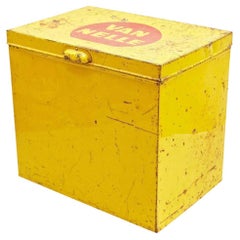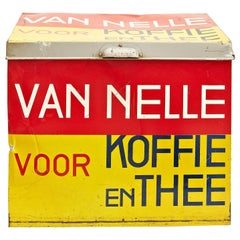Jacques Jongert
Recent Sales
Vintage 1930s Dutch Mid-Century Modern Tea Caddies
Metal
Vintage 1930s Dutch Mid-Century Modern Tea Caddies
Metal
Vintage 1930s Dutch De Stijl Tea Caddies
Vintage 1930s Dutch Mid-Century Modern Tea Caddies
Metal
Early 20th Century Dutch Mid-Century Modern Decorative Boxes
Metal
A Close Look at Mid-century-modern Furniture
Organically shaped, clean-lined and elegantly simple are three terms that well describe vintage mid-century modern furniture. The style, which emerged primarily in the years following World War II, is characterized by pieces that were conceived and made in an energetic, optimistic spirit by creators who believed that good design was an essential part of good living.
ORIGINS OF MID-CENTURY MODERN FURNITURE DESIGN
- Emerged during the mid-20th century
- Informed by European modernism, Bauhaus, International style, Scandinavian modernism and Frank Lloyd Wright’s architecture
- A heyday of innovation in postwar America
- Experimentation with new ideas, new materials and new forms flourished in Scandinavia, Italy, the former Czechoslovakia and elsewhere in Europe
CHARACTERISTICS OF MID-CENTURY MODERN FURNITURE DESIGN
- Simplicity, organic forms, clean lines
- A blend of neutral and bold Pop art colors
- Use of natural and man-made materials — alluring woods such as teak, rosewood and oak; steel, fiberglass and molded plywood
- Light-filled spaces with colorful upholstery
- Glass walls and an emphasis on the outdoors
- Promotion of functionality
MID-CENTURY MODERN FURNITURE DESIGNERS TO KNOW
- Charles and Ray Eames
- Eero Saarinen
- Milo Baughman
- Florence Knoll
- Harry Bertoia
- Isamu Noguchi
- George Nelson
- Danish modernists Hans Wegner and Arne Jacobsen, whose emphasis on natural materials and craftsmanship influenced American designers and vice versa
ICONIC MID-CENTURY MODERN FURNITURE DESIGNS
- Eames lounge chair
- Nelson daybed
- Florence Knoll sofa
- Egg chair
- Womb chair
- Noguchi coffee table
- Barcelona chair
VINTAGE MID-CENTURY MODERN FURNITURE ON 1STDIBS
The mid-century modern era saw leagues of postwar American architects and designers animated by new ideas and new technology. The lean, functionalist International-style architecture of Le Corbusier and Bauhaus eminences Ludwig Mies van der Rohe and Walter Gropius had been promoted in the United States during the 1930s by Philip Johnson and others. New building techniques, such as “post-and-beam” construction, allowed the International-style schemes to be realized on a small scale in open-plan houses with long walls of glass.
Materials developed for wartime use became available for domestic goods and were incorporated into mid-century modern furniture designs. Charles and Ray Eames and Eero Saarinen, who had experimented extensively with molded plywood, eagerly embraced fiberglass for pieces such as the La Chaise and the Womb chair, respectively.
Architect, writer and designer George Nelson created with his team shades for the Bubble lamp using a new translucent polymer skin and, as design director at Herman Miller, recruited the Eameses, Alexander Girard and others for projects at the legendary Michigan furniture manufacturer.
Harry Bertoia and Isamu Noguchi devised chairs and tables built of wire mesh and wire struts. Materials were repurposed too: The Danish-born designer Jens Risom created a line of chairs using surplus parachute straps for webbed seats and backrests.
The Risom lounge chair was among the first pieces of furniture commissioned and produced by celebrated manufacturer Knoll, a chief influencer in the rise of modern design in the United States, thanks to the work of Florence Knoll, the pioneering architect and designer who made the firm a leader in its field. The seating that Knoll created for office spaces — as well as pieces designed by Florence initially for commercial clients — soon became desirable for the home.
As the demand for casual, uncluttered furnishings grew, more mid-century furniture designers caught the spirit.
Classically oriented creators such as Edward Wormley, house designer for Dunbar Inc., offered such pieces as the sinuous Listen to Me chaise; the British expatriate T.H. Robsjohn-Gibbings switched gears, creating items such as the tiered, biomorphic Mesa table. There were Young Turks such as Paul McCobb, who designed holistic groups of sleek, blond wood furniture, and Milo Baughman, who espoused a West Coast aesthetic in minimalist teak dining tables and lushly upholstered chairs and sofas with angular steel frames.
Generations turn over, and mid-century modern remains arguably the most popular style going. As the collection of vintage mid-century modern chairs, dressers, coffee tables and other furniture for the living room, dining room, bedroom and elsewhere on 1stDibs demonstrates, this period saw one of the most delightful and dramatic flowerings of creativity in design history.
Finding the Right Tea-caddies for You
There are lots of uses for your vintage, new or antique tea caddies, but they can certainly serve their original intended purpose if needed.
When tea first gained popularity during the 1800s, and teatime became commonplace in homes all over England, it was an expensive commodity owing to excessive taxation. (This, of course, inevitably yielded a black market for tea leaves.) Tea drinkers hoarded their precious goods, which began to arrive in London ports from China during the 17th century, under lock and key. In luxury homes, tea leaves were stowed away in a decorative jar or canister called a tea caddy that was fitted with a lock, or, alternatively, the container was kept in a secured chest or storage cabinet.
Tea was thought to be not just a delicious drink but also to have medicinal benefits. The Chinese had been praising the healthy properties of tea, and wealthy Europeans were eager to discover its benefits for themselves during their ritual afternoon tea. The idea of “teatime” wasn’t a social event in upper-class British homes until the 1830s or 1840s. During Queen Victoria’s reign, small baked treats might be served with your beverage, and teakettles and coffeepots were part of tea services that could include teacups, saucers, a milk pot and other accessories.
When tea cultivation was relegated to British colonies such as India, and the British East India Company could no longer hold onto its trade monopoly with China, tea was no longer a ritual confined to the wealthy. Today, antique and vintage tea caddies are collector’s items all over the world.
Tea caddies weren’t unique to Europeans. The earliest pieces originated in China. Surviving hand-painted examples from China or elsewhere in Asia made of porcelain might feature enameled landscapes or other designs. At the Taft Museum of Art, there are striking enameled 18th-century-era tea caddies of copper that were given to the institution in 2014. Wooden tea caddies materialized over time and were seen as sturdier than their ceramic counterparts.
Today, there are all kinds of ways to use a vintage tea caddy if you’re passing on tea. They’re a welcome decorative flourish on the mantel in your living room, for example. A metal tea caddy, lined with a plastic bag, can be used to cultivate an herb garden on your kitchen windowsill. An old wooden tea caddy can help keep your paper clips or pushpins organized on your desk too. If you’re always on the go, a tea tin is good for packing earbuds, hand sanitizer, gum or whatever else that might get easily lost in a roomy crossbody messenger bag or other shoulder bag.
Teatime or not, find antique and vintage mid-century modern tea caddies, tortoiseshell caddies and more on 1stDibs.
Read More
How Noguchi Elevated Ashtrays to Objets d’Art
Smoking might have fallen out of fashion, but these ashtrays have enduring design appeal.
Jeff Andrews Captures Old Hollywood Glamour in His Cinematic Spaces
Having created extravagant homes for reality TV’s biggest stars, the designer is stepping into the spotlight with his first book.
Tapio Wirkkala Bucked the Trends of Mid-Century Nordic Design
The Finnish talent created nature-inspired pieces, from furniture to jewelry, with phenomenal staying power.

